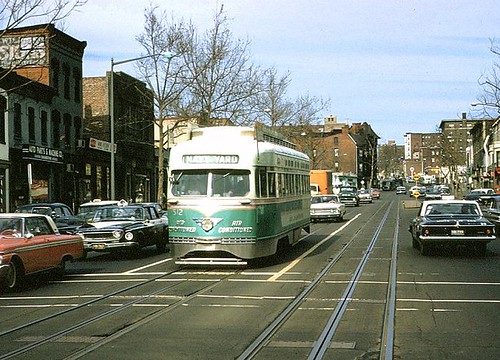This is a little heuristic of my own, and the criteria for "classification" would include presence of amenities within walking distance, including a neighborhood-serving commercial district, ideally quality schools and public libraries, subway service as opposed to bus service, and as streetcar service is operationalized streetcar service over bus service, income demographics, and similar kinds of factors.
This comes up because of the single use Walmart proposed for the Curtis Chevrolet site at 5928 Georgia Avenue NW, in the face of the previous proposal for a mixed use development with housing about about 50,000 square feet of ground floor retail.
Foulger-Pratt, the developer of the site, is whining that they can't get financing to do anything other than a Walmart. Actually, Walmart does their own financing, so Foulger-Pratt doesn't have to do much other than get building permits and cash some checks, which wouldn't be the case if a mixed use development were on the table.
This is my framework for evaluating the economic opportunity of various DC submarkets.
A = Downtown, A+ = Downtown/with easy transit access
B = nice or potentially nice areas with transit access (Columbia Heights and Capitol Hill = B+, Petworth and H Street = B, B- might be Takoma and Brookland--they are nice areas, but the commercial amenities are weak, especially for younger demographics)
C = places farther out, with or without transit (Fort Totten, Georgia Avenue north of Petworth)
D = further out, impoverished, with transit (Deanwood, Minnesota Avenue, Anacostia, etc.)
E = further out, no transit access
This isn't an official scale, think of it as a heuristic related to strictly market-based construction initiatives not relying on any public financing or other assistance.
Just because I rate an area B or C or D doesn't mean that such projects aren't doable, or that they won't get built until all the A projects go through the pipeline. It all depends on the projects, the developers, and their ability to get financing. Projects with public money and/or other forms of assistance will get built as a result of different criteria, which is fine of course, because it's about spurring revitalization, not just the market. B-D projects get built faster or slower or "out of sequence" depending on the nature of the deal, especially if public money is involved.
The issue with Georgia Avenue north of Petworth is mostly the lack of access to high quality transit--the subway--although the corridor has frequent bus service including limited stop (semi-express) bus service during rush periods, and about 15,000 people daily ride the buses along the corridor.
DC Transit streetcar, street unknown. Joe Testagrose Collection, Dave's Railpix.
Likely if plans for streetcar service on Georgia Avenue were moved forward more quickly, significant acceleration of revitalization along the corridor would be likely to occur. In fact, the best economic development initiative for Ward 4 would be the streetcar,
except for maybe Dave Murphy's idea for the separated yellow line (which I have come around to support).
The interesting thing about the Walmart proposals is that the developers are hungry, because of the downturn over the last two years. Walmart, with its ability to finance its own deals, is looked upon eagerly by developers who haven't been doing deals.
But the moment for these deals is maybe reaching the crest. Even though companies like Foulger-Pratt are pleading poverty and lack of access to capital as a justification for a single use of otherwise more developable properties, more commercial real estate and multiunit residential development deals are starting to be funded, especially in Washington, and the Commercial Mortgage Backed Securities financing market is opening back up, according to
Retail Traffic Magazine. See "
CMBS Lenders Are Coming Back, as is Their Appetite for Risk."





1 Comments:
This is a great post.
Visit here-cheap medicines usa.
Post a Comment
<< Home